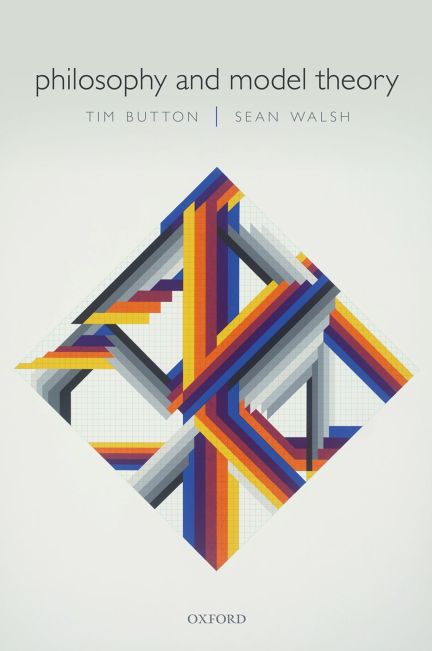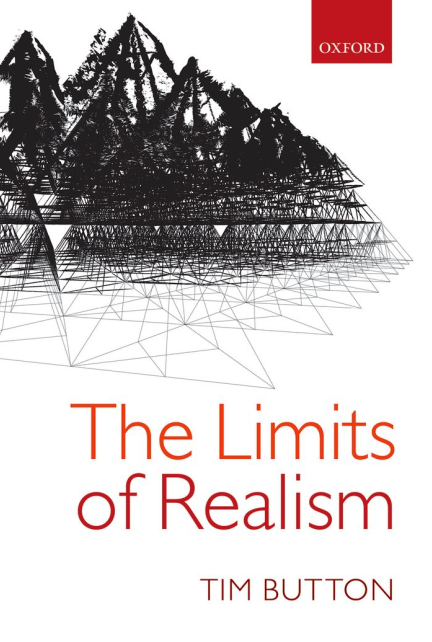
Philosophy and Model Theory
2018. Coauthored with Sean Walsh.
With a historical appendix by Wilfrid Hodges.
Oxford University Press.
[]
[doi]
[]
[errata]
[pop-exposition]

The Limits of Realism
2013.
Oxford University Press.
[]
[doi]
[]
Lieven Decock, Notre Dame Philosophical Reviews. [url]
Nicholas K Jones, Analysis. [doi] [preprint]
Drew Khlentzos, Australasian Journal of Philosophy [doi]
Rory Madden, European Journal of Philosophy. [doi] [preprint]
J.T.M. Miller, Philosophy in Review. [doi]
Joshua Thorpe, Argumenta. [doi]
Jan Westerhoff, Mind. [doi]
Nathan Wildman, Zeitschrift für philosophische Forschung. [preprint]
forthcoming. Why are all the sets all the sets? Noûs. [] [preprint]
forthcoming. Why sum types, or even some types at all? Coauthored with Robert Trueman. Disputatio. [] [draft]
forthcoming. Too clever by halving. Coauthored with Daniel Rothschild and Levi Spectre. Oxford Studies in Epistemology. [] [draft]
2025. The iterative conception of function and the iterative conception of set. In N. Barton, C. Antos, and G Venturi (eds.), Palgrave Companion to the Philosophy of Set Theory. Palgrave. [] [preprint]
2024. Wand/Set Theories: A realization of Conway’s mathematicians’ liberation movement, with an application to Church’s set theory with a universal set. Journal of Symbolic Logic. [] [doi]
2024. A fictionalist theory of universals. Coauthored with Robert Trueman. In P. Fritz and N. Jones (eds.), Higher-Order Metaphysics. OUP: 245–90. [] [preprint]
2023. Symmetric relations, symmetric theories, and Pythagrapheanism. Philosophy and Phenomenological Research, 107.3: 583–612. [] [open access doi]
2022. Against cumulative type theory. Coauthored with Robert Trueman. Review of Symbolic Logic, 15.4: 907–49. [] [open access doi]
2022. Mathematical internal realism. In J. Conant and S. Chakraborty (eds.), Engaging Putnam. De Gruyter: 157–182. [] [doi] [preprint]
2022. Level Theory, part 3: A boolean algebra of sets arranged in well-ordered levels. Bulletin of Symbolic Logic, 28.1: 1–26. [] [doi] [preprint]
2021. Level Theory, part 2: Axiomatizing the bare idea of a potential hierarchy. Bulletin of Symbolic Logic, 27.4: 461–84. [] [doi] [preprint]
2021. Level Theory, part 1: Axiomatizing the bare idea of a cumulative hierarchy of sets. Bulletin of Symbolic Logic, 27.4: 436–60. [] [doi] [preprint]
2020. Deflationary metaphysics and ordinary language. Synthese 197.1: 33–57. [] [open access doi]
2018. Other minds and God: Russell and Stout on James and Schiller. In M. Baghramian and S. Marchetti (eds.), Pragmatism and the European Traditions. Routledge: 86–109. [] [doi] [preprint]
2018. Wittgenstein on solipsism in the 1930s: Private pains, private languages, and two uses of ‘I’. Royal Institute of Philosophy Supplement 82: 205–29. [] [doi] [preprint]
2017. Exclusion problems and the cardinality of logical space. Journal of Philosophical Logic 46.6: 611–23. [] [open access doi]
2017. Grades of Discrimination: Indiscernibility, symmetry, and relativity. Notre Dame Journal of Formal Logic 58.4: 527–53. [] [open access doi]
2016. Brains in vats and model theory. In S. Goldberg (ed.), The Brain in a Vat, CUP: 131–54. [] [doi] [preprint]
2016. Knot and Tonk: Nasty connectives on many-valued truth-tables for classical sentential logic. Analysis 76.1: 7–19. [] [doi] [preprint]
2016. Structure and categoricity: Determinacy of reference and truth-value in the philosophy of mathematics. Coauthored with Sean Walsh. Philosophia Mathematica 24.3: 283–307. [] [doi] [preprint]
2014. The weight of truth: Lessons for minimalists from Russell’s Gray’s Elegy argument. Proceedings of the Aristotelian Society 114.3: 261–89. [] [doi] [preprint]
2012. The philosophical significance of Tennenbaum’s Theorem. Coauthored with P. Smith. Philosophia Mathematica, 20.1: 114–21. [] [doi] [preprint]
2011. The metamathematics of Putnam’s model-theoretic arguments. Erkenntnis 74.3: 321–49. [] [doi] [preprint]
2010. Dadaism: restrictivism as militant quietism. Proceedings of the Aristotelian Society 110.3: 387–98. [] [doi] [preprint]
2009. Hyperloops do not threaten the notion of an effective procedure. Lecture Notes in Computer Science 5635: 68–78. [] [doi] [preprint]
2009. SAD computers and two versions of the Church–Turing Thesis. British Journal for the Philosophy of Science 60.4: 765–92. [] [doi] [preprint]
2007. Every now and then, no-futurism faces no sceptical problems. Analysis 67.4: 325–32. [] [doi] [preprint]
2019. Review of: Hilary Putnam on Logic and Mathematics, by Geoffrey Hellman and Roy T. Cook (eds.). Mind, 129.516: 1327–37. [] [doi] [preprint]
2017. Review of: Naturalism, Realism, and Normativity, by Hilary Putnam, edited by Mario de Caro. Philosophy 92.2: 305–15. [] [doi] [preprint]
2016. Review of: Ontology After Carnap, by Stephan Blatti and Sandra Lapointe (eds.). Notre Dame Philosophical Reviews. [] [url] [preprint]
2014. Review of: Reading Putnam, by Maria Baghramian (ed.). Mind 123.490: 569–75. [] [doi] [preprint]
2013. The chair that is used to sit in. Review of: The American Pragmatists, by Cheryl Misak. The Times Literary Supplement 18 October 2013. [] [preprint]
On the other tabs, you can find my research sorted by type. Here, they are grouped by their main theme, with some repetition.
Sets & levels
forthcoming. Why are all the sets all the sets? Noûs. [] [preprint]
2025. The iterative conception of function and the iterative conception of set. In N. Barton, C. Antos, and G Venturi (eds.), Palgrave Companion to the Philosophy of Set Theory. Palgrave. [] [preprint]
2024. Wand/Set Theories: A realization of Conway’s mathematicians’ liberation movement, with an application to Church’s set theory with a universal set. Journal of Symbolic Logic. [] [doi]
2022. Level Theory, part 3: A boolean algebra of sets arranged in well-ordered levels. Bulletin of Symbolic Logic, 28.1: 1–26. [] [doi] [preprint]
2021. Level Theory, part 2: Axiomatizing the bare idea of a potential hierarchy. Bulletin of Symbolic Logic, 27.4: 461–84. [] [doi] [preprint]
2021. Level Theory, part 1: Axiomatizing the bare idea of a cumulative hierarchy of sets. Bulletin of Symbolic Logic, 27.4: 436–60. [] [doi] [preprint]
2022. Against cumulative type theory. Coauthored with Robert Trueman. Review of Symbolic Logic, 15.4: 907–49. [] [open access doi]
Model theory
2018. Philosophy and Model Theory. Coauthored with Sean Walsh. OUP. [] [doi] [errata]
2016. Structure and categoricity: Determinacy of reference and truth-value in the philosophy of mathematics. Coauthored with Sean Walsh. Philosophia Mathematica 24.3: 283–307. [] [doi] [preprint]
2013. The Limits of Realism, chapters 1–7. OUP. [] [doi]
2012. The philosophical significance of Tennenbaum’s Theorem. Coauthored with P. Smith. Philosophia Mathematica, 20.1: 114–21. [] [doi] [preprint]
2011. The metamathematics of Putnam’s model-theoretic arguments. Erkenntnis 74.3: 321–49. [] [doi] [preprint]
Type theory
forthcoming. Why sum types, or even some types at all? Coauthored with Robert Trueman. Disputatio. [] [draft]
2024. A fictionalist theory of universals. Coauthored with Robert Trueman. In P. Fritz and N. Jones (eds.), Higher-Order Metaphysics. OUP: 245–90. [] [preprint]
2022. Against cumulative type theory. Coauthored with Robert Trueman. Review of Symbolic Logic, 15.4: 907–49. [] [open access doi]
Equivalent theories
See also: the papers on Sets & levels.
2023. Symmetric relations, symmetric theories, and Pythagrapheanism. Philosophy and Phenomenological Research, 107.3: 583–612. [] [open access doi]
2018. Philosophy and Model Theory, chapter 5. Coauthored with Sean Walsh. OUP. [] [doi] [errata]
2013. The Limits of Realism, chapters 18–19. OUP. [] [doi]
Reactions to scepticism
See also: the publications on Model Theory.
2022. Mathematical internal realism. In J. Conant and S. Chakraborty (eds.), Engaging Putnam. De Gruyter: 157–182. [] [doi] [preprint]
2018. Philosophy and Model Theory, chapters 9–13. Coauthored with Sean Walsh. OUP. [] [doi] [errata]
2016. Brains in vats and model theory. In S. Goldberg (ed.), The Brain in a Vat, CUP: 131–54. [] [doi] [preprint]
2016. Knot and Tonk: Nasty connectives on many-valued truth-tables for classical sentential logic. Analysis 76.1: 7–19. [] [doi] [preprint]
2013. The Limits of Realism. OUP. [] [ doi]
2010. Dadaism: restrictivism as militant quietism. Proceedings of the Aristotelian Society 110.3: 387–98. [] [doi] [preprint]
Metaphysics
2025. The iterative conception of function and the iterative conception of set. In N. Barton, C. Antos, and G Venturi (eds.), Palgrave Companion to the Philosophy of Set Theory. Palgrave. [] [draft]
2024. A fictionalist theory of universals. Coauthored with Robert Trueman. In P. Fritz and N. Jones (eds.), Higher-Order Metaphysics. OUP: 245–90. [] [preprint]
2023. Symmetric relations, symmetric theories, and Pythagrapheanism. Philosophy and Phenomenological Research, 107.3: 583–612. [] [open access doi]
2020. Deflationary metaphysics and ordinary language. Synthese 197.1: 33–57. [] [open access doi]
2017. Exclusion problems and the cardinality of logical space. Journal of Philosophical Logic 46.6: 611–23. [] [open access doi]
2017. Review of: Naturalism, Realism, and Normativity, by Hilary Putnam, edited by Mario de Caro. Philosophy 92.2: 305–15. [] [doi] [preprint]
2016. Review of: Ontology After Carnap, by Stephan Blatti and Sandra Lapointe (eds.). Notre Dame Philosophical Reviews. [] [url] [preprint]
2014. Review of: Reading Putnam, by Maria Baghramian (ed.). Mind 123.490: 569–75. [] [doi] [preprint]
2007. Every now and then, no-futurism faces no sceptical problems. Analysis 67.4: 325–32. [] [doi] [preprint]
2006. Realistic structuralism’s identity crisis: A hybrid solution. Analysis 66.3: 216–22. [] [doi] [preprint]
The self
2018. Wittgenstein on solipsism in the 1930s: Private pains, private languages, and two uses of ‘I’. Royal Institute of Philosophy Supplement 82: 205–29. [] [doi] [preprint]
2018. Other minds and God: Russell and Stout on James and Schiller. In M. Baghramian and S. Marchetti (eds.), Pragmatism and the European Traditions. Routledge: 86–109. [] [doi] [preprint]
Computation
2009. Hyperloops do not threaten the notion of an effective procedure. Lecture Notes in Computer Science 5635: 68–78. [] [doi] [preprint]
2009. SAD computers and two versions of the Church–Turing Thesis. British Journal for the Philosophy of Science 60.4: 765–92. [] [doi] [preprint]
Miscellaneous
2019. Review of: Hilary Putnam on Logic and Mathematics, by Geoffrey Hellman and Roy T. Cook (eds.). Mind, 129.516: 1327–37. [] [doi] [preprint]
2017. Grades of Discrimination: Indiscernibility, symmetry, and relativity. Notre Dame Journal of Formal Logic 58.4: 527–53. [] [open access doi]
2014. The weight of truth: Lessons for minimalists from Russell’s Gray’s Elegy argument. Proceedings of the Aristotelian Society 114.3: 261–89. [] [doi] [preprint]
2013. The chair that is used to sit in. Review of: The American Pragmatists, by Cheryl Misak. The Times Literary Supplement 18 October 2013. [] [preprint]
2013. Review of: Truth by Analysis: Games, Names, and Philosophy, by Colin McGinn. Analysis 73.3: 577–80. [] [doi] [preprint]
draft (retired with probability ⅔). Too clever by halving. Coauthored with Daniel Rothschild and Levi Spectre. [] [draft]